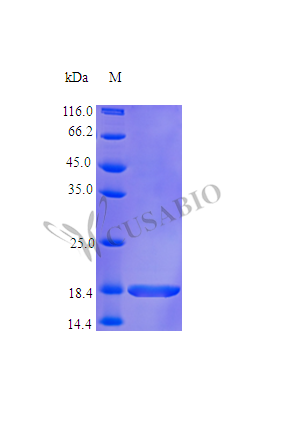Recombinant Human AIMP1 protein is expressed in E. coli and corresponds to the 147-312 amino acid region of the human protein. This tag-free, partial-length protein is purified to a level greater than 98% as determined by SDS-PAGE. It appears to be fully biologically active, with an ED50 of less than 40 ng/ml for inducing apoptosis in serum-free MCF-7 cells, indicating a specific activity of over 2.5 × 10^4 IU/mg. The endotoxin level is maintained below 1.0 EU/µg, ensuring suitability for research applications.
AIMP1, also known as aminoacyl tRNA synthase complex-interacting multifunctional protein 1, plays what seems to be a critical role in protein synthesis by interacting with aminoacyl tRNA synthetases. Beyond its involvement in translation, AIMP1 is recognized for its multifunctional nature. It participates in various cellular pathways, including apoptosis and immune response modulation - though the full extent of these roles may not be completely understood. Its diverse functions make it an important protein for studying cellular processes and disease mechanisms in research settings.
Potential Applications
Note: The applications listed below are based on what we know about this protein's biological functions, published research, and experience from experts in the field. However, we haven't fully tested all of these applications ourselves yet. We'd recommend running some preliminary tests first to make sure they work for your specific research goals.
1. Apoptosis Induction Studies in Cancer Cell Lines
This recombinant AIMP1 fragment is confirmed to be biologically active in inducing apoptosis in MCF-7 cells (ED₅₀ < 40 ng/ml) and suitable for apoptosis studies. However, the partial sequence (147-312aa) may not fully recapitulate the apoptotic mechanisms of full-length AIMP1, as important functional domains may be missing. Researchers should validate that apoptosis pathways (e.g., caspase activation, mitochondrial membrane potential changes) match those induced by full-length AIMP1. The moderate potency requires careful dose optimization across different cancer cell types.
2. Protein-Protein Interaction Mapping
The biologically active AIMP1 fragment can be used for interaction studies, but the partial nature may miss important binding partners that interact with the missing N-terminal domain. While suitable for mapping interactions within the 147-312aa region, researchers should validate key interactions with full-length AIMP1 to ensure biological relevance. The tag-free design minimizes artifacts, but comprehensive interaction mapping requires full-length protein studies.
3. Antibody Development and Validation
This high-purity AIMP1 fragment serves as a good antigen for generating domain-specific antibodies. However, antibodies will only recognize epitopes within the 147-312aa region and may miss important conformational epitopes requiring the full-length protein. Comprehensive antibody validation should include testing against full-length AIMP1 to ensure recognition of all functional domains. The confirmed bioactivity supports the development of function-blocking antibodies targeting this specific region.
4. Structure-Function Relationship Studies
The fragment is valuable for studying structure-function relationships within the 147-312aa region, but it cannot inform about functions dependent on the missing N-terminal domain. Mutagenesis studies should focus on this specific region, and conclusions should be contextualized as representing partial AIMP1 functionality. Comparative studies with full-length AIMP1 are essential to determine the relative importance of this region in overall protein function.
5. Cell Death Pathway Screening Assays
The protein is suitable for screening assays, but the moderate potency (ED₅₀ < 40 ng/ml) may limit sensitivity in high-throughput formats. Screening campaigns should be designed with appropriate concentration ranges and include full-length AIMP1 as a positive control to ensure identified modulators are relevant to the complete protein's function. The low endotoxin supports specific activity attribution, but hit validation should include full-length protein confirmation.
Final Recommendation & Action Plan
This recombinant human AIMP1 partial fragment (147-312aa) demonstrates confirmed apoptotic activity but has moderate potency and lacks the full-length protein's complete functional domains. For immediate use, employ it in the 20-100 ng/ml range for apoptosis studies, but validate that key apoptotic mechanisms (caspase activation, Bcl-2 family modulation) match full-length AIMP1 responses. When mapping protein interactions, use this fragment for initial screening, but confirm critical interactions with the full-length protein. For antibody development, this fragment is ideal for generating domain-specific reagents, but to validate comprehensive epitope coverage with full-length AIMP1. The E. coli expression produces a non-glycosylated protein, which is acceptable as AIMP1 is not heavily glycosylated, but critical findings should be verified with a mammalian-expressed full-length protein when studying complex biological functions. Always include full-length AIMP1 controls in key experiments to ensure biological relevance, and consider that different cancer cell types may exhibit varying sensitivity to this fragment based on their expression of AIMP1 receptors and downstream signaling components.






